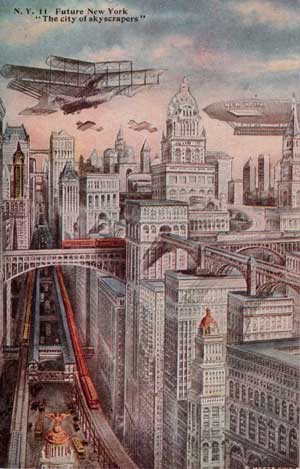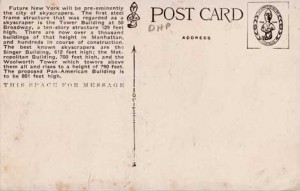Among the publications of Moses King is a curious postcard titled N.Y. 11 Future New York “The city of skyscrapers”. John Timberman Newcomb, teacher at University of Illinois, Urbana-Champaign, wrote a piece titled The Footprint of the Twentieth Century: American Skyscrapers and Modernist Poems citing it as being published sometime in 1913-1918. I picked my copy up at a local store that sells old and used postcards.

The back reads, “Future New York will be pre-eminently the city of skyscrapers. The first steel frame structure that was regarded as a skyscraper is the Tower Building at 50 Broadway, a ten-story structure 129 feet high. There are now over a thousand buildings of that height in Manhattan, and hundreds in course of construction. The best known skyscrapers are the Singer Building, 612 feet height the Metropolitan Building, 700 feet high, and the Woolworth Tower which towers above them all at rises to a height of 790 feet. The proposed Pan-American Building is to be 801 feet high.â€

For comparison, The Empire State Building is 1,472 feet including the spire, doubling what the 1900’s regarded as towering. It remains one of the tallest buildings in America and is currently number 15 world-wide. An impressive iconic structure, the Empire State Building is far from the vision that this postcard imagines.
Modern futuristic movies reach out into space (2001, Star Wars), explore extraterrestrials (ET, Alien) and robotic life (Short Circuit, Terminator). Others imagine close calls with the end of humanity (I Am Legend, Men in Black). Others yet explore genetic (Gattaca) and psychic phenomena (Minority Report). To make these movies commercially accessible they are kept edgy-plausible. In comparison, the minds of the 1900’s went far more radical imaging a metropolis of buildings stacked upon buildings with rail cars at high elevations and the possibility that a person’s world may be contained within one building. Movies have riffed on these concepts but at 750 ft, the Woolworth Tower was a far from the futuristic city New York was thought to become.
In general, the current state of futuristic thinking lacks radical imagination. The fiction has become too accessible offering probable possibilities instead of the kind of “what if†thinking that raises the societal consciousness – what could be beyond what we think.
There was a time that my work focused on managing technology diffusion and amplifying the volume on innovative activity at IBM. It is a space where there is literally no shortage of work to be done at every level. While people tended to focus on the tangible build out of infrastructure or web experience that facilitated innovation access, most failed to see how important the dream was. For example. “what if 30,000 employees were always running the n+1 version of the IT experience?†Dreams are lenses that provide a critical filter and check point as things naturally evolve and depart from the original motivations.
Making innovation accessible is an important part of the Darwinian selection. A more interesting topic is pushing innovation beyond current understanding. Quite simply, the majority of innovation today is incremental or copy cat – applying something from one domain to another in hopes it might be useful in a different context. Certainly interesting exploration, but not what I would call transformative. It seems real innovation comes in the form of individuals and when they move on for whatever reason, so does the dream. Who in your world is a dreamer that has started many fires but whose fires seem to be smothered or worse yet have burned the wrong forest?
Consider what is still an impressive demonstration, Jeff Han’s demo at TED in February 2006. It is 2009 and the best we have seen of gesture based and multi-touch, pressure sensitive computer screen technology and the best we can point to is Apple’s application in their mobile devices. More importantly, notice the first demo Han shows exploring human lava lamp interactions – more sophisticated than current interaction experiences that exploration is relegated to research scientists. The few hundred of audience members, purported to be some of the most connected in the world, were impressed and unmoved to imagine a different computing world, or if imagined selfishly horded.
What is beyond web-based anything, micro-blogging, social flows and the constant meme generation? I am not tired of the world we live in, but who is imagining the world beyond. If we simply evolve from here, the future will fall short, just like the New York and cities that never became. Some cite the state of the economical climate as the reason for such underwhelming thinking. I think it has been here for many years and it would be a good time to shake it up. If you are a dreamer, a futurist, a creative thinker, why is your volume so soft? The future is here and we need bigger thoughts.

